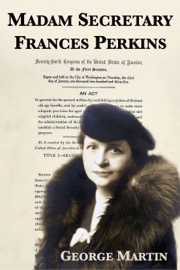 $9.99 on Kindle
$9.99 on Kindle(cover by Susan Erony)
Madam Secretary Frances Perkins by George W. Martin (234,000 words and 24 illustrations)
Frances Perkins (1880-1965) attended Mount Holyoke College, majoring in physics. In her final semester, she visited mills along the Connecticut River to see working conditions as part of a class in American economic history. She was horrified. Instead of teaching until she married, she earned a masters degree in social work from Columbia University. In 1910, Perkins became Executive Secretary of the New York City Consumers League. She campaigned for sanitary regulations for bakeries, fire protection for factories, and legislation to limit the working hours for women and children in factories to 54 hours per week. She worked mainly in New York State’s capital, Albany, where she befriended politicians and learned how to lobby.
On March 25, 1911, Perkins was with friends in New York City when they heard fire engines. Running to see what was happening, they witnessed one of the worst workplace disasters in US history: the Triangle Shirtwaist Factory fire killed 146 people, mostly young women and girls. Perkins saw fire escapes collapse, firemen’s ladders unable to reach the women trapped by the flames and 47 workers leap to their deaths from the 8th and 9th floors. A year earlier these same women and girls had fought for and won the 54-hour work week and other benefits that Perkins had championed. Perkins at that moment resolved to make sure their deaths would not be in vain.
Perkins became the secretary of a committee formed to study reforms in safety in factories. Besides fire safety, the committee took on all other health issues they could think of. By that time a respected expert witness, Perkins helped draft the most comprehensive set of laws regarding workplace health and safety in the country. Other states started copying New York’s new laws to protect workers.
Perkins continued to work in New York for decades, until she was asked by President Elect Franklin D. Roosevelt in 1933 to serve as Secretary of Labor. She told him only if he agreed with her goals: 40-hour work week, minimum wage, unemployment and worker’s compensation, abolition of child labor, federal aid to the states for unemployment, Social Security, a revitalized federal employment service, and universal health insurance. He agreed and Perkins became America’s first woman Cabinet member, serving as Secretary of Labor from 1933 until 1945. One of her cabinet colleagues was Interior Secretary Harold L. Ickes. Similar to what she achieved in New York State, her successes became the New Deal, and changed the country and its workers forever.
“George Martin [has] produce[d] an almost totally absorbing book, one that not only brings Miss Perkins to life, but also one that quivers with the excitement that the New Deal generated in most Americans... Mr. Martin’s book is well‐researched... Madam Secretary is full of rewards, not the least of them being that it gives stature to a woman Americans will be richer for knowing.” — Alden Whitman, The New York Times
“A sturdy biography of the first woman Cabinet member.” — The New York Times
“George Martin’s volume is more than a biography... he has produced a volume that should rank high in the current literature of political science.” — Isador Lubin, Monthly Labor Review
“[A] rich, scholarly account of the life of this remarkable woman... the biography has an immediate, conversational, almost autobiographical quality.” — Ronald L. Filippelli, Business History Review
“[A] remarkably personal look at a very private woman... [a] comprehensive picture of [Frances Perkins].” — Sarah A. Morrison, Social Service Review
“Martin does full justice to Perkins’ abilities as administrator, legislative guide and public spokesman... [a] valuable book.” — Kirkus Reviews



